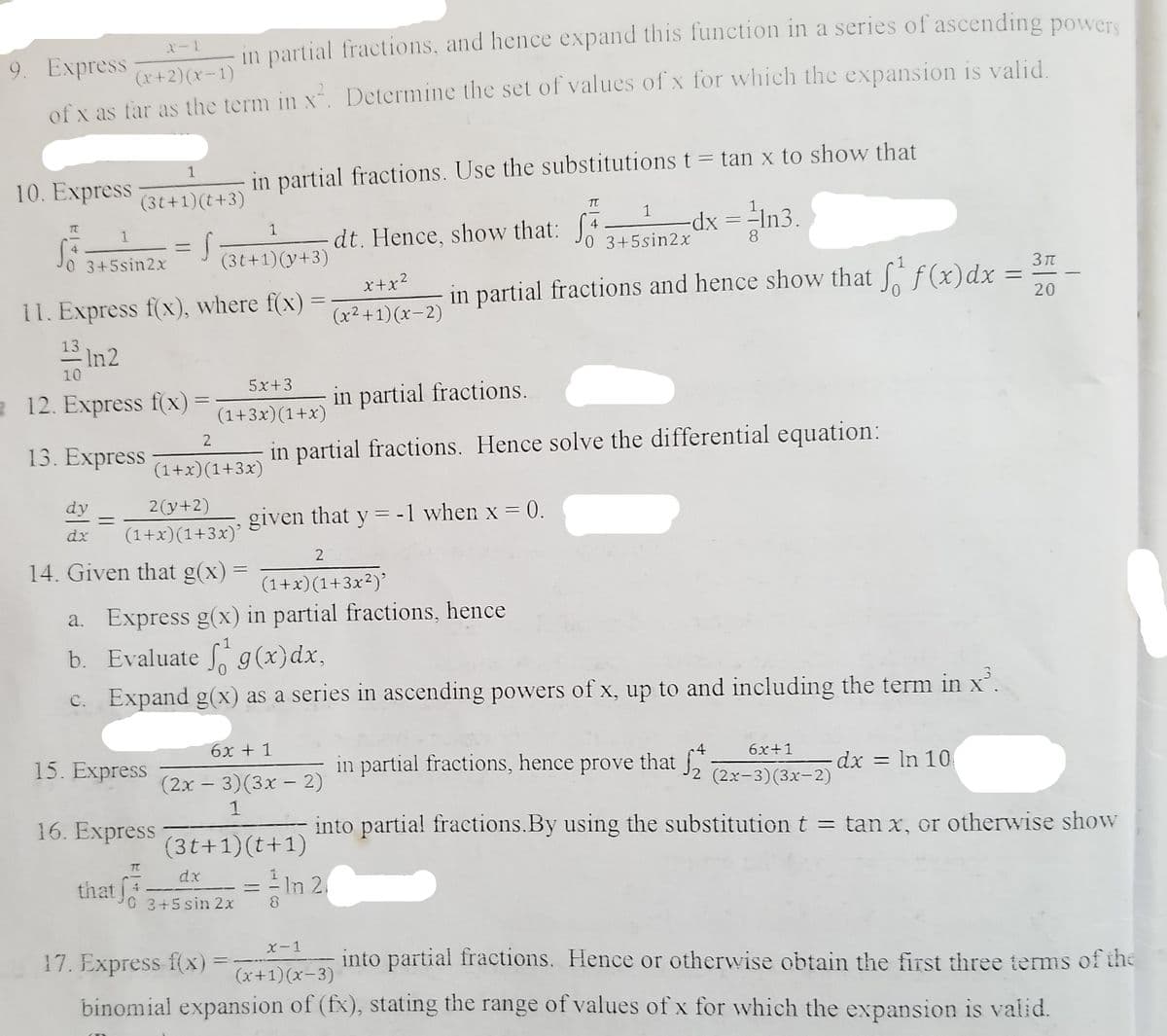2 14. Given that g(x) (1+x)(1+3x2)' a. Express g(x) in partial fractions, hence b. Evaluate g(x)dx, c. Expand g(x) as a series in ascending powers of x, up to and including the term in x'.
2 14. Given that g(x) (1+x)(1+3x2)' a. Express g(x) in partial fractions, hence b. Evaluate g(x)dx, c. Expand g(x) as a series in ascending powers of x, up to and including the term in x'.
College Algebra (MindTap Course List)
12th Edition
ISBN:9781305652231
Author:R. David Gustafson, Jeff Hughes
Publisher:R. David Gustafson, Jeff Hughes
Chapter6: Linear Systems
Section6.6: Partial Fractions
Problem 62E: Match the rational expression on the left with the correct partial fraction decomposition form on...
Related questions
Concept explainers
Equations and Inequations
Equations and inequalities describe the relationship between two mathematical expressions.
Linear Functions
A linear function can just be a constant, or it can be the constant multiplied with the variable like x or y. If the variables are of the form, x2, x1/2 or y2 it is not linear. The exponent over the variables should always be 1.
Question
Solve Q14a, b & c showing clearly all steps involved

Transcribed Image Text:in partial fractions, and hence expand this function in a series of ascending powers
9. Express
(x+2)(x-1)
of x as far as the term in x. Determine the set of values of x for which the expansion is valid.
%3D
1
in partial fractions. Use the substitutions t= tan x to show that
10. Express
(3t+1)(t+3)
dx =-In3.
8
1
dt. Hence, show that: 4
1
0 3+5sin2x
4.
ニ
0 3+5sin2x
(3t+1)(y+3)
3 t
x+x?
in partial fractions and hence show that f(x)dx
20
11. Express f(x), where f(x)
13 In2
(x²+1)(x-2)
10
5x+3
2 12. Express f(x) =
in partial fractions.
(1+3x)(1+x)
2
13. Express
in partial fractions. Hence solve the differential equation:
(1+x)(1+3x)
dy
2(y+2)
given that y = -1 when x = 0.
dx
(1+x)(1+3x)'
14. Given that g(x) =
(1+x)(1+3x²)’
a. Express g(x) in partial fractions, hence
b. Evaluate g(x)dx,
c. Expand g(x) as a series in ascending powers of x, up to and including the term in x'.
6x + 1
6x+1
15. Express
in partial fractions, hence prove that
,
2 (2x-3)(3x-2)
dx = In 10
(2x – 3)(3x – 2)
1
16. Express
into partial fractions.By using the substitution t = tan x, or otherwise show
(3t+1)(t+1)
TT
dx
that 3+5sin 2x
= In 2.
||
X-1
17. Express f(x)
into partial fractions. Hence or otherwise obtain the first three terms of the
(x+1) (x-3)
binomial expansion of (fx), stating the range of values of x for which the expansion is valid.
Expert Solution
This question has been solved!
Explore an expertly crafted, step-by-step solution for a thorough understanding of key concepts.
Step by step
Solved in 2 steps with 2 images

Knowledge Booster
Learn more about
Need a deep-dive on the concept behind this application? Look no further. Learn more about this topic, calculus and related others by exploring similar questions and additional content below.Recommended textbooks for you

College Algebra (MindTap Course List)
Algebra
ISBN:
9781305652231
Author:
R. David Gustafson, Jeff Hughes
Publisher:
Cengage Learning

Algebra & Trigonometry with Analytic Geometry
Algebra
ISBN:
9781133382119
Author:
Swokowski
Publisher:
Cengage

College Algebra (MindTap Course List)
Algebra
ISBN:
9781305652231
Author:
R. David Gustafson, Jeff Hughes
Publisher:
Cengage Learning

Algebra & Trigonometry with Analytic Geometry
Algebra
ISBN:
9781133382119
Author:
Swokowski
Publisher:
Cengage